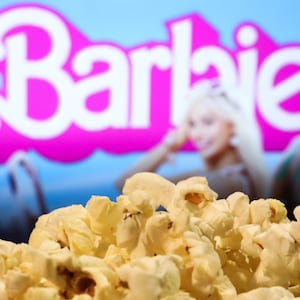Four years ago, actress and future Barbie president Issa Rae snuck in a little dig against the Oscars while announcing 2020’s directing nominees live. Like most years’ crops, they were all men. In the months leading upt othe nominations, both Lulu Wang and Greta Gerwig had emerged as likely contenders for The Farewell and Little Women, but neither made the final list. As Rae put it on stage, “Congratulations to those men.”
This year’s Academy Award nominations brought the usual snubs and surprises, but no contender has generated as much attention as the Barbie movie. Ryan Gosling and America Ferrera will compete for Best Supporting Actor and Actress, and the film has also been nominated in categories including Best Adapted Screenplay and Best Picture and two Best Original Song entries. Still, Barbie lovers on social media are more than a little annoyed that Margot Robbie will not be in contention for Best Actress while Greta Gerwig has been locked out of the director’s race once again. Sobbing Barbie GIFs are spreading across the internet like a hot pink mushroom cloud of disappointment.
As disappointing as Robbie’s exclusion might be, Gerwig’s seems genuinely egregious. It illustrates multiple frustrating impulses within the Academy, most of all its historic failure to recognize and celebrate female directors.
It’s worth remembering that neither Robbie nor Gerwig has been shut out from the Oscars race entirely; as a producer, Robbie is still in the race for Best Picture, and Gerwig and her husband, Noah Baumbach, are up for the screenplay. Nevertheless, even Hillary Rodham Clinton has entered the chat with a post seemingly comparing her 2016 electoral college loss to the film’s losses with the Academy. (“While it can sting to win the box office but not take home the gold, your millions of fans love you,” she wrote, throwing in a confounding “#HillaryBarbie” hashtag for good measure.)
At the risk of setting my inbox on fire, I’m not entirely convinced Robbie’s Best Actress miss is that serious of a rejection—and not just because she still could be honored as a producer. The Best Actress category was impossibly stacked this year, and, as always, plenty of deserving nominees—including Greta Lee, who turned in a soul-stirring performance in Past Lives—did not make the cut. And while Robbie did some marvelous work in Barbie, the film itself also did not appear nearly as interested in her character as it was in Gosling’s Ken, who even got the show-stopping, newly Oscar-nominated musical number.
Looking beyond the Best Actress race, the idea that, thanks to the Academy, a man has become the sole figurehead of a film about women also feels like an insult to America Ferrera. Controversial as her character’s monologue might have been, her nomination stands at the exact same level as Gosling’s. As bummed as some of us might be for Robbie, those who erase Ferrera’s nod for the sake of a simpler narrative are saying more about themselves than anything else.
But Gerwig’s snub feels more troublesome. If this oversight were just one isolated incident, it wouldn’t feel so vexing. But taken within the broader context of Oscars history, it’s a symptom of a much larger problem.
Only eight female directors have ever been nominated for Best Director, and only three have ever won. Tellingly, all three of those wins occurred within the last 15 years. Interestingly, women tend to do better in the Best Documentary category, but even there, we could stand to do better.
In 2009, The Hurt Locker director Kathryn Bigelow became the first woman to receive the award, and more than a decade later, Chloé Zhao became the second with Nomadland. Jane Campion snagged the award for The Power of the Dog a year later, a mini-trend that seemed to mark some progress from an exceedingly low bar. Still, we’ve got a long way to go; 2021 marked the only year when two women received simultaneous nominations in the category—Zhao for Nomadland and Emerald Fennell for Promising Young Woman—and the Academy has yet to nominate even one Black or Latina woman for the award. The historic nature of this year’s Best Picture category only makes all of this feel more depressing. Of the 10 films nominated for Best Picture, women directed a whopping, record-breaking three—and of those three, only one, Anatomy of a Fall director Justine Triet, also received a directing nod.

Greta Gerwig on the set of Barbie.
Jaap BuitendijkTriet has more than earned the recognition she’s received. Her film is a gripping courtroom drama that doubles as a complex character study, and her nomination should be celebrated. It’s also true that the Best Picture race, with its 10 nomination slots, offers more room than the five-spot director’s race—so some eligible nominees will naturally find themselves vying for one gold statuette but not the other. Still, when combined with the knowledge that only eight—eight!—women have ever actually gotten to compete for best director, the reality Gerwig’s loss represents feels pretty stark.
The Academy has long devalued the work of women within this industry. If you exclude the acting categories (which obviously include men and women) the USC Annenberg’s Inclusion Initiative found last year that since the first Oscars ceremony in 1929, only 12% of all nominations have gone to women. Of course, the statistic for women of color is even more damning—just 1%. We can quibble about logistics and category slots all day (or, in this case, 95 years), but at a certain point, the numbers start to speak for themselves.
Statistically, female writer-directors have a far better shot of scoring a screenplay nomination than they do a directing nomination. As someone who enjoyed the hell out of Barbie as a cinematic experience but had some serious qualms about its writing, its nomination for screenplay over direction confirms just how arbitrary these recognitions really can be.
As a general party pooper, I remain unconvinced that Barbie is actually the rich feminist text that its fans insist it to be. For one thing, the film never grapples with the actual origins of its central doll, the design of which its creator Ruth Handler lifted from a popular German bachelor party gift—a racy secretary character that some described as a call girl. According to Insider, Handler didn’t like the few fashion dolls available to girls at the time because their “flat chests, big bellies, and squatty legs” looked to her like “overweight six- or eight-year-olds.” The film also does not meaningfully engage with race, class, or body image, so even if we did grant that it is a feminist text, the depth and nuance of its feminism is severely limited. As written, Barbie’s script feels more like marketing propaganda than an insightful examination of the doll or her place in our culture. (Personally, I didn’t need the film to dig that deep, but I’ve been surprised to see how many people honestly believe it did so.)
Meanwhile, the script’s actual attempts at feminist meditations—like Barbie crying at the sight of an old woman, or America’s monologue about How Hard It Is to Be a Woman—feel pretty trite next to its inventive and often subtextual exploration of toxic masculinity through Ken. If you look at these approaches side by side, it becomes easier to understand why Gosling might’ve stood out more to awards voters than Robbie did—fairly or not.
Barbie’s direction, on the other hand? To borrow a turn of phrase from Lady Gaga, it’s “talented, brilliant, incredible, amazing, show stopping, spectacular, never the same, totally unique, completely not ever been done before, unafraid to reference or not reference, put it in a blender, shit on it, vomit on it, eat it, give birth to it.” From that hilarious office chase scene to Barbie’s deeply relatable brand of millennial-girl ennui, each element feels fine-tuned for maximum visual impact. (Put that still of Barbie lying on the ground in despair on a dish towel, please, if someone hasn’t already.) As difficult as farce can be to both achieve and maintain, Gerwig and her cast absolutely nailed it.

Greta Gerwig’s direction was a vital part of Barbie’s success.
Jaap BuitendijkIf that wasn’t enough, the film’s most memorable sequences are all homages to Old Hollywood-era filmmaking. The Barbie-and-Ken travel montage employed a series of moving backgrounds, a practical effect that’s fallen by the wayside thanks to advances in computer-generated visual effects, and Ken’s dream ballet is the kind of dance number that would’ve made greats like Gene Kelly smile. Instead of relying on CGI, as is now commonplace, Gerwig—like her Barbenheimer contemporary, the best directing nominee and practical effects aficionado Chris Nolan—took the hard route instead.
On top of all this, Gerwig’s Barbie became a massive commercial success, driving millions to theaters at a time when box offices are still crumbling. But directors like Steven Spielberg, who lost out on a Best Director nomination for Jaws in 1976, know better than anyone that “commercial backlash” is a thing at the Oscars. Add in the fact that Barbie is a frothy comedy instead of a dark, serious story like those told by other female directing nominees, and Gerwig’s absence from the roster starts to feel even more inevitable. While the film manages to create a genuinely funny coming-of-age story out of a plastic doll, that’s also not the kind of success the Oscars have ever been keen to reward. (Translation: Despite some exceptions, the Oscars tend to hate comedies.)
Regardless of why Gerwig lost out on a directing nomination, her banishment from the category for both Barbie and Little Women fits into a larger problem that the Academy will need to address if it hopes to stay relevant. Women make up more than half of this country’s population, and as Barbie and artists like Beyoncé and Taylor Swift have proven, they can also drive unprecedented audience numbers. The Oscars need not acknowledge every movie based on commercial success—in fact, please do not do that—but when a feat of classic filmmaking actually also plants butts in theater seats in the age of artistically empty CGI soup, it might be smart to recognize the person who made that miracle happen.







